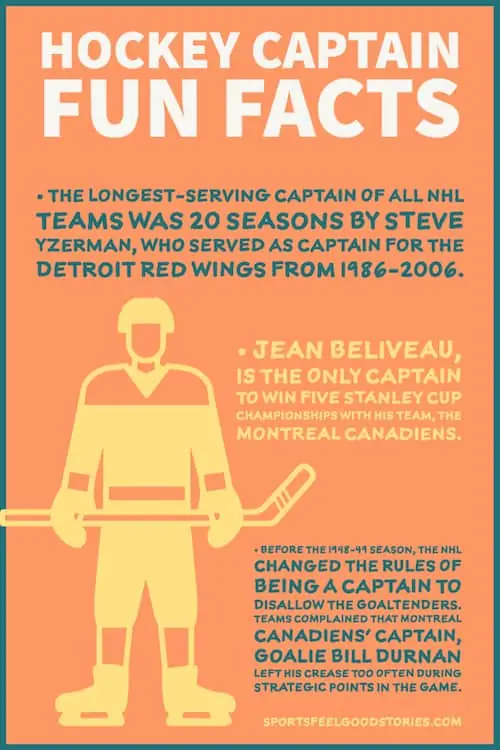Being a hockey captain or an alternate on a hockey team is more than just a title or even having that extra letter stitched on a jersey. It has a distinct meaning to those on the team. But it also comes with some responsibility.
Captain or Alternate Captain Definition
The hockey captain or alternate captain on a team refers to three players, one captain, and two alternates. Each team can only have one captain, and to help identify him, he has the letter C stitched on his uniform. Each of the alternates has the letter A on theirs.
Key Takeaways
Typically, there is one captain and two alternates for every team.
The role of the captain is to converse with the officials on the ice and be a representative of the team off the ice.
Goalies are not allowed to be captains according to NHL rule changes in the NHL 1948-49 season.
There is no rule that states there must be a captain; therefore, the team may choose to have alternates or co-captains until the right decision can be made.

The Role of the Captain
Think of the captain as the connection between the referees and the rest of the team. Sometimes penalties are called, and the reasoning is unclear; the captain will be the one to get clarification from the referees. Clarification may also be needed for other on-ice decisions.
The captain will then take this information and relay it to his coach and teammates. This is done because, in a heated moment, it can be tempting to have the whole team charge the referees. Having one representative helps keep the conversation calmer.
One alternate will take his place if the captain is on the bench during the play, in the sin bin, or even injured. This is why they have the name alternate, as opposed to assistant. They are not there to assist so much as take on his role when the captain can’t.
See The Incomparable Doc Emrick.
The Leadership Role of Captains
Now that we’ve addressed both the captain and alternates’ roles on the ice let’s look a little deeper. In many ways, the captain is the leader of the team. He must be respected by the management and coaches and, most importantly, by the team and the fans.
They are expected to behave as a role model for their team members and those who follow and love hockey, particularly the fans. They are often even the face of the team during press conferences or other public events.
The team and fans take the hockey captain role seriously, so much so that they often have a ceremony. Watch the following video where Bo Horvat is named the captain of the Vancouver Canucks. He is presented this honor by former captains Henrik Sedin and Orland Kurtenbach, last and first captains, respectively.
Being Named an NHL Captain Video
Who Can Serve as Captain?
The only player who cannot serve as a captain or alternate is the goalie. It is too disruptive for a goalie to take on this role, but that wasn’t always the case. In fact, in NHL history, six goalies have had the honor of this role.
They are in order:
- John Ross Roach, Toronto St. Patricks, 1924-25.
- George Hainsworth, Montreal Canadiens, 1932-33.
- Roy Worters, New York Americans, 1932-33.
- Alec Connell, Ottawa Senators, 1932-33.
- Charlie Gardiner, Chicago Black Hawks, 1933-34.
- Bill Durnan, Montreal Canadiens, 1947-48.
See 99 Funniest Hockey Jokes and One-Liners.
The Loophole
Since then, no more goalies have served as captains of a team… or so I thought. Then I remembered that in the 2008-09 season, Mike Gillis, the team president and general manager of the Vancouver Canucks, named Robert Luongo captain of his team.
This is what I meant that a captain’s role goes deeper than his on-ice duties. Despite this technically not being allowed, the Canucks figured out a loophole. Willie Mitchell, a defensive player, would do the grunt work of the captain’s duties on the ice.
This meant, however, that Luongo would still need to handle all the other duties off the ice. From being the spokesperson of the team to additional captain expectations. In the end, it became too much for him, and in 2010 he resigned from his captaincy.
And in case you are wondering, yes, there has been a time when a captain resigned from his role out of anger. In the 1980 NHL season, Darryl Sittler, a forward for the Toronto Maple Leafs, tore off his C from his sweater and quit after he heard the team had traded his best friend, Lanny McDonald.
But anger isn’t the only reason a captain may lose his title; a captain can also be demoted. Check out the video below to hear some hard moments of five NHL players who lost their captaincy titles.
Who Chooses the Captain?
This leads us to the choice of a captain. While in Luongo’s case, it was a managerial decision, often it is the team’s choice. It may be because he is a veteran player or possibly because he is a lead scorer. But in all likelihood, he is already a leader in the locker room.
Fun Facts About Hockey Captains
Steve Yzerman was the longest-serving captain of all NHL teams – 20 seasons. He served as captain for the Detroit Red Wings from 1986-2006.
The youngest player to ever be selected as captain was Brian Bellows, who played for the Minnesota North Stars (a former NHL team) and took his captaincy in 1984. He was 19 years and 131 days old. It should be noted, however, that he was an interim captain when the original North Star captain Craig Hartsburg was injured.
The next youngest captain selected in the NHL (so far) is Connor McDavid of the Edmonton Oilers at the ripe age of 19 years 266 days in 2016.
Jean Beliveau is the only captain to win five Stanley Cup Championships with his team, the Montreal Canadiens.
Before the 1948-49 season, the NHL changed the rules of being a captain to disallow goaltenders. Teams complained that Montreal Canadiens’ captain, goalie Bill Durnan left his crease too often during strategic points in the game. This resulted in unscheduled timeouts and is now referred to as the Durnan Rule.

The Durnan Rule Explained Video
What if There is No Hockey Captain?
Sometimes, a captain cannot be decided upon. In this case, three alternates can be chosen. Although I do find it interesting, if not offending, that one of the three doesn’t seem up to snuff to fill the role, who am I to judge?
There have been some interesting moments in NHL history when there has been no captain or even two or more. In 1985-86 Boston Bruins captain Terry O’Reilly retired. The team couldn’t decide, and both Ray Bourque and Rick Middleton were named as co-captains.
The honor of wearing the C was split between the seasons, with Middleton wearing it during the home games and Bourque for the away games, then at the halfway point, they switched. In 1988 when Middleton retired, Bourque upheld the title.
The Buffalo Sabres did the same during the 2005-06 and 2006-07 seasons when they named Daniel Briere and Chris Drury. And the Minnesota Wild rotated captaincy for nine (that’s crazy!) years, every month or two, until Mikko Koivu was finally given the permanent title in the 2009-10 NHL season.
Final Thoughts on the Hockey Captain Role
The roles of a captain and alternatives are to be taken seriously and are measured both on and off the ice. Not only are they there to communicate with the officials, but they are there to bond with their team, encourage them when they are down, and be role models to fans and fellow teammates alike.
By Danielle L’Ami
Danielle is a Canadian writer and Hab’s fan who is still reeling that her team just beat the Leafs in their first playoff series of the last 42 years. She will be watching the next series with her three lucky charms, kids, and Tampa Bay-loving husband, double-supporting her team.
Overtime
You are on our What Being a Hockey Captain Means page.
You might like:
Hockey Parents: Tips for Being Chill
Teddy Bear Toss at Hockey Game
